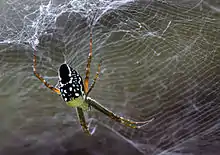Cyrtophora moluccensis
Cyrtophora moluccensis is a tent-web spider in the orb-weaver family. It is commonly known as the tent spider or dome-web spider, and is native to India, Japan, Indonesia, Papua New Guinea, Australia, Fiji, and Tonga.[1] It is often found in disturbed or open habitats from coasts to forest and mountainous interiors.[2][3]
| Cyrtophora moluccensis | |
|---|---|
 | |
| Specimen in the Australian Museum | |
| Scientific classification | |
| Kingdom: | Animalia |
| Phylum: | Arthropoda |
| Subphylum: | Chelicerata |
| Class: | Arachnida |
| Order: | Araneae |
| Infraorder: | Araneomorphae |
| Family: | Araneidae |
| Genus: | Cyrtophora |
| Species: | C. moluccensis |
| Binomial name | |
| Cyrtophora moluccensis Doleschall, 1857 | |
| Synonyms[1] | |
| |
The abdomen is high and the anterior end overhangs the cephalothorax. It can be distinguished from similar species by the two tubercles on its abdomen, its elaborate pattern, and, in females, the shape of the median septum of the epigyne. In males, the embolus of the pedipalp is enclosed within the conductor.[3] Females and immature spiders are yellow to green in color.[4]
Webs built by Cyrtophora species are different than typical webs built by orb-weavers. The orb web is built horizontally with a finely meshed dome or bowl shape, hence the name "dome-web spider". The non-sticky spiral is left intact and webs are without a sticky spiral.[5] A 1980 study suggests that this type of web derives from the typical orb web and not the other way around.[2] These webs are durable, sometimes lasting several weeks, so they don't need to be remade every day like the webs of most spiders.
Webs can be either solitary or colonial, though even in groups, each web is defended by its owner. Colonial groups can cover an area of fifteen meters squared and include over four hundred individuals, including fifty adults.[6] Young spiders will often build their nests within the space of that of their parent's. Webs of this spider have also been known to be host to Argyrodes miniaceus or young spiders of other species.[3]
Subspecies
- Cyrtophora moluccensis albidinota (Strand, 1911) – Caroline Islands, Palau, Yap
- Cyrtophora moluccensis bukae (Strand, 1911) – Solomon Islands
- Cyrtophora moluccensis cupidinea (Thorell, 1875) – New Caledonia
- Cyrtophora moluccensis margaritacea (Doleschall, 1859) – Java
- Cyrtophora moluccensis rubicundinota (Strand, 1911) – Keule Islands, near New Guinea
Gallery
 Cyrtophora moluccensis in Cairns
Cyrtophora moluccensis in Cairns With prey in Kobe, Japan
With prey in Kobe, Japan Shape of the web in Okinawa
Shape of the web in Okinawa Female with eggsac in Okinawa
Female with eggsac in Okinawa
References
- "Taxon details". World Spider Catalog. Natural History Museum Bern. 2015-03-17. Retrieved 2016-01-14.
- Lubin, Y.D. (1980). "The predatory behavior of Cyrtophora (Araneae:Araneidae)". Journal of Arachnology. 8: 159–185.
- Koh, J.K.H. (1991). "Spiders of the Family Araneidae in Singapore Mangroves". The Raffles Bulletin of Zoology. 39: 169–182.
- "Tent Spider". Brisbane Garden. Retrieved 2016-01-17.
- Davies, V.T. (1988). "An illustrated guide to the genera of orb-weaving spiders in Australia". Memoirs of the Queensland Museum. 25: 273–332.
- Berry, J.W. (1987). "Notes on the life history and behaviour of the communal spider Cyrtophora moluccensis (Doleschall) in Yap, Caroline Islands". Journal of Arachnology. 15: 309–319.